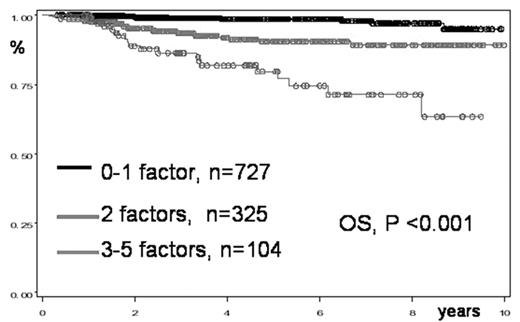Abstract
Actually, the prognosis of localized Hodgkin’s lymphoma (HL) patients may be assessed by different scoring systems. Although many similar characteristics have been identified, these scoring systems are not easy to relate to advanced stage HL. The aim of the present study was to refine the assessment of risk using the published scoring systems and to construct a statistical model for predicting risk of death. We report here the results of the EORTC, GHSG and Canadian-ECOG scoring systems obtained in 1156 patients for whom hematological data were available among the 1390 patients with localized HL prospectively treated within GELA centres in H8 (518 pts) and H9 (638 pts) trials. The International prognostic score (IPS) was available only for the H9 subset. All patients have been treated with radio-chemotherapy of different intensity or duration according to their prognostic factors. Median age was 30 yr [14–69] and age≥45yr.: 18%, female 50%; stage 1: 25%; stage 2: 75%; B symptoms with elevated ESR: 40%; number of nodal sites 1–2: 52%; ≥3: 48%; extra nodal involvement: 8%, bulky mediastinum> 0.35, 28%; elevated ESR> 50:33%; Hb< 10.5 g/dl: 7%; Lymphocytes < 600/μl: 6%; WBC > 15000/μl:11 %; albumin< 40g/l: 37%. With the EORTC scoring system 36% of patients had favourable HL, with GHSG 35% and with Canadian-ECOG 38%. The IPS was 0 in 19% and 1 in 45%. With a median follow up of 42 months, 54 patients died. Survival curves according to the different scoring systems significantly discriminated favourable and unfavourable patients outcomes (5 yrs OS 95% vs 92%, p=0.01). By multivariate Cox analysis, age > 45yr (RR=2.0), sex male (RR=2.5), haemoglobin <10.5g/dl (RR=2.3), lymphocytes < 600/μL (RR=3.6), B symptoms with elevated ESR (RR=3.6), extra nodal sites (RR=1.2) retained a significant prognostic value. The 5 yrs OS was 99%, 98%, 92%, 82%, 73% for patients with 0,1, 2, 3, 4–5 factors respectively (p< 0.0001, see figure). 10% of the patients had 3–5 factors. The covariates selection was validated by the bootstrap method. The introduction of albumin< 40g/l in the H9 subset population did not bring more significant information. In conclusion, these factors are similar with those described in the IPS when stages 3–4 are replaced by extra nodal (E) localization. They should be validated in other prospective trials because such a scoring system could unify the assessment of the prognosis for HL patients and facilitate the treatment choice.
Author notes
Corresponding author


This feature is available to Subscribers Only
Sign In or Create an Account Close Modal